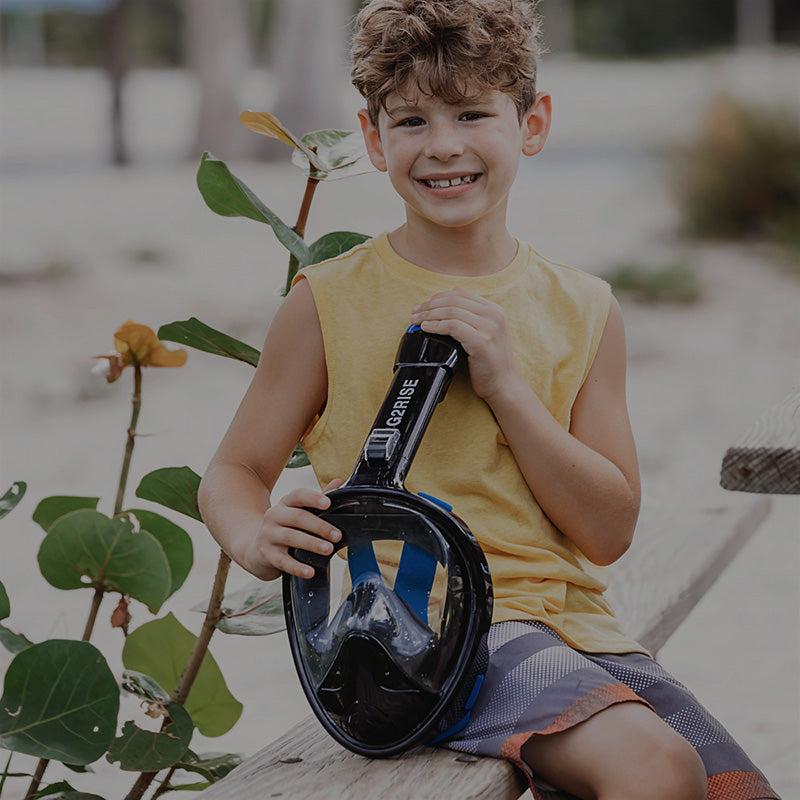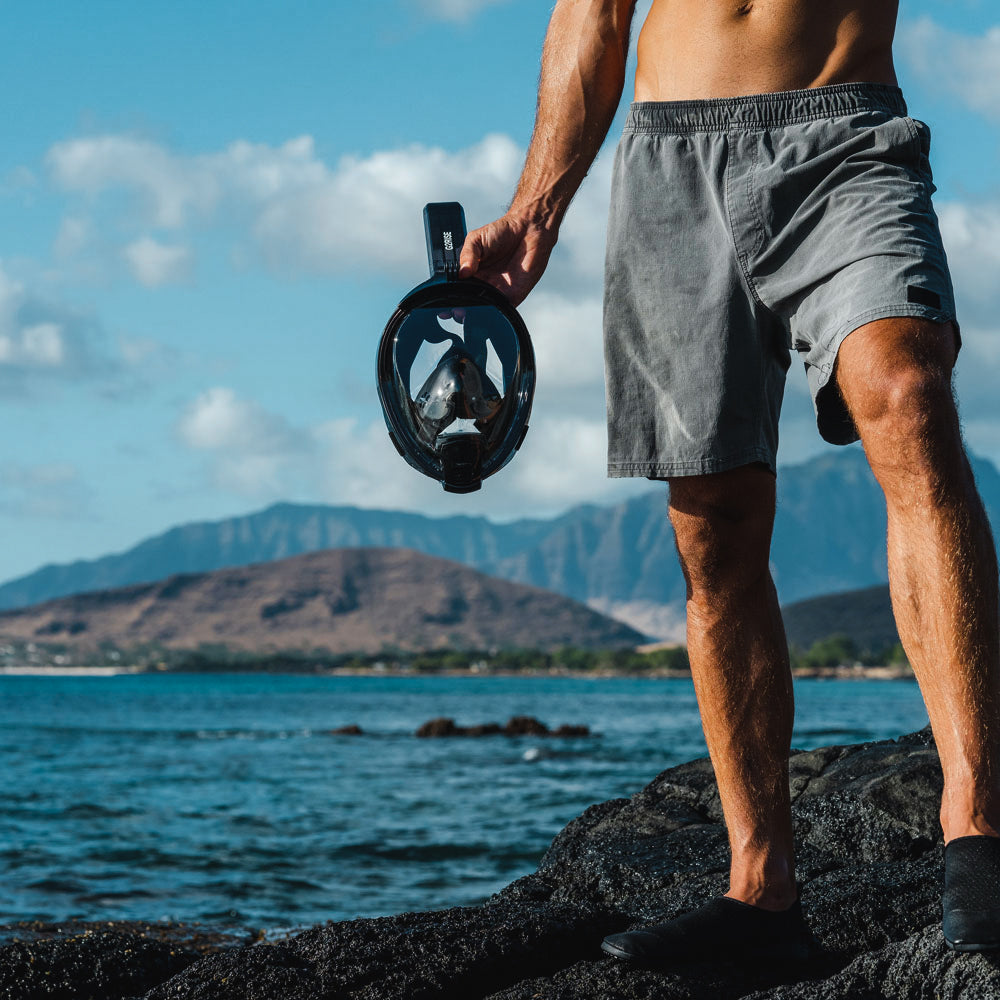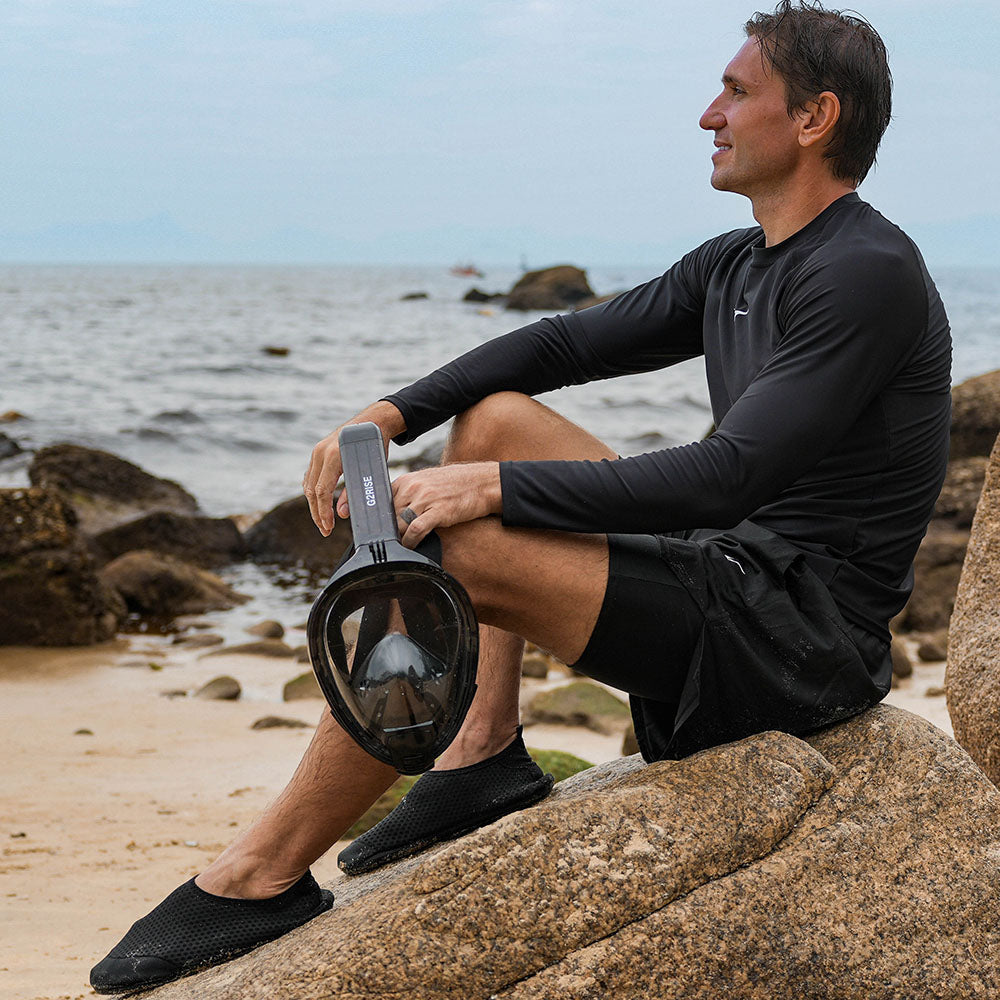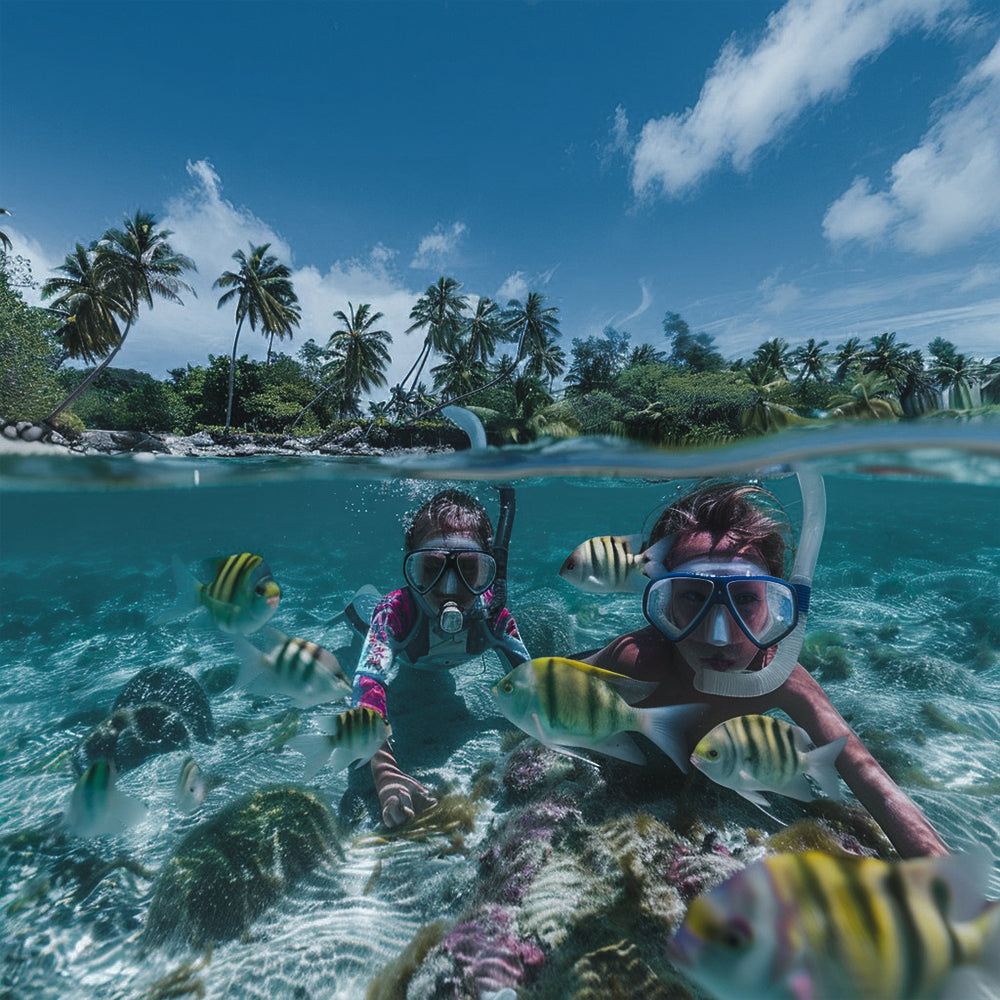Encountering a sea turtle while snorkeling is an incredible experience, but many people unknowingly disturb these gentle creatures and their habitats simply because they haven't learned how. This guide provides essential guidelines for enjoying sea turtles responsibly, particularly when using a full-face snorkel mask. You'll learn about maintaining safe distances, using your gear correctly, and understanding turtle behavior signals. Following these practices helps ensure your presence doesn't harm the turtles or their ocean home, allowing for respectful encounters whether you're new to snorkeling or have years of experience.

What You Need to Know About Sea Turtle Conservation
Sea turtles face significant threats globally, leading to severe population declines for most species. Understanding their conservation status and the impact of human interaction is the first step towards responsible viewing.
Current Numbers Show Turtle Crisis:
Six of the seven sea turtle species are currently listed as threatened or endangered. Factors like ocean pollution, entanglement in fishing gear, coastal development disrupting nesting sites, and illegal hunting have drastically reduced their numbers. For instance, Pacific leatherback populations have plummeted by roughly 95% over the last two decades. While conservation efforts are helping some green turtle populations slowly recover, the overall situation remains critical.
How Watching Affects Turtles:
Getting too close can easily stress a sea turtle, potentially causing it to stop feeding, flee its resting place, or even abandon important habitats altogether. Repeated disturbances can alter their natural behavior patterns. Conversely, when snorkelers maintain a respectful distance and behave calmly, turtles are more likely to continue their activities undisturbed.
Protected Areas and Rules:
Many popular turtle-watching locations have specific regulations to minimize human impact. Common rules often include:
- Maintaining a distance of 10-15 feet (3-5 meters).
- Strictly prohibiting touching or chasing turtles.
- Banning flash photography.
- Limiting group sizes (often 4-6 people).
- Suggesting limited viewing times (e.g., 15-30 minutes).
- Always verify local regulations before your trip, as requirements for permits, seasonal closures, restricted zones, mandatory guides, and specific beach access rules vary significantly.
Places like Hawaii and the Great Barrier Reef have well-established guidelines. Adhering to these rules is crucial for protecting turtle populations, especially in areas popular with tourists. Fines for violations can be substantial.

How to Prepare for Turtle Watching
Proper preparation, including selecting appropriate gear and understanding timing, significantly increases your chances of seeing turtles behave naturally and minimizes your impact.
Essential Equipment Guide:
Full-Face Snorkel Mask:
Choose a mask that seals comfortably against your face without excessive pressure. Look for clear, anti-fog treated lenses and breathing valves designed for quiet operation. A proper fit is essential for both safety and effectiveness, making personal masks preferable to borrowed ones.
Dark Blue or Black Gear Only:
Opt for simple, dark-colored swimwear and gear (black or dark blue). Bright colors can potentially startle turtles accustomed to the ocean's muted tones. Ensure your fins are designed for gentle propulsion over sensitive seabeds, and secure any loose straps or equipment that could snag on coral or algae. A simple flotation aid can help you remain horizontal and avoid accidental kicking of the bottom.
Zinc-Based Sunscreens Without Harmful Chemicals:
Protecting yourself from the sun is important, but standard sunscreens containing chemicals like oxybenzone, octinoxate, or octocrylene can wash off and harm coral reefs and marine life, including turtles. Choose reef-safe, mineral-based sunscreens (zinc oxide or titanium dioxide) and apply them at least 20-30 minutes before entering the water.
When to See Turtles:
Timing the Seasons:
While specific timing varies by location, turtles are generally more abundant in warmer waters during spring and summer (roughly March to August). Nesting seasons often occur during summer months but differ regionally. Fewer turtles are typically seen in most tourist snorkeling areas during winter.
Optimal Daily Hours:
Early morning (around 6-10 AM) and late afternoon are often prime feeding times. Mid-morning might find turtles actively swimming or visiting "cleaning stations." Around midday, they frequently rest in shallower areas. Local conditions influence these patterns.
Considering the Tides:
Tide cycles affect turtle movements. They often move closer to shore during rising tides and over reefs at high tide. During low tide, they typically retreat to deeper water. Consulting local tide charts helps pinpoint promising viewing times.

Safe Ways to Watch Sea Turtles
With the right gear and timing, mastering proper viewing techniques is the next crucial step. Maintaining appropriate distance and managing group behavior are key to protecting the turtles while allowing for meaningful observation.
- Maintain a Respectful Distance (15-Foot Rule): Never swim directly toward a turtle. Always keep at least 15 feet (about 5 meters, or three adult body lengths) between yourself and the animal. If a turtle happens to swim towards you, calmly and slowly back away to maintain the gap. Position yourself parallel to or slightly behind the turtle, never directly in front, which could block its path.
- Recognize Normal Turtle Behaviors: Undisturbed turtles typically exhibit steady swimming, surface periodically and calmly for air, and continue feeding or resting despite your presence. They might casually raise their heads to scan their surroundings. Smooth, unhurried movements generally indicate the turtle feels secure. Observing these signs suggests you are maintaining an appropriate distance.
-
Identify Stress Signals and React Appropriately: Immediately increase your distance if a turtle:
- Suddenly changes direction to avoid you.
- Begins swimming much faster than before.
- Abruptly stops feeding or resting.
- Dips its head down while increasing speed.
- Makes frantic movements.
These are clear indicators of stress. If you observe any of these, stop moving forward, quietly swim backward, and give the turtle significantly more space.
- Keep Your Group Small (Under 6 People): Smaller groups create less potential disturbance and provide a better viewing experience for everyone. If snorkeling with a larger party, split into groups of 4-6 people maximum. Ensure different groups maintain ample space (at least 30 feet) between them to avoid inadvertently surrounding a turtle.
- Form a Wide Semi-Circle, Not a Tight Crowd: If observing a resting or slow-moving turtle, spread out loosely behind or to the side, forming a wide semi-circle. This allows everyone a view without crowding and, crucially, leaves a clear, unobstructed path forward for the turtle should it choose to move. Never encircle a turtle completely.
- Communicate Quietly with Hand Signals: Avoid talking loudly, which can carry underwater and potentially disturb turtles. Use simple, pre-arranged hand signals for communication (e.g., pointing to indicate location, tapping your head for shallow hazards, crossing arms to signal giving more space). Quiet coordination helps maintain a calm environment.

How to Optimize Your Full-Face Mask for Minimal Disturbance
Knowing the rules of engagement is vital; properly using your full-face mask enhances your observation while minimizing your impact.
Control Your Breathing:
Breathe slowly and evenly through your nose. Unlike traditional snorkels requiring mouth breathing, the FFM uses nasal breathing. Quick, sharp, or deep gasps create more noise and bubbles, which can easily startle turtles. Aim for relaxed, almost sleep-like breathing.
Direct Bubbles Thoughtfully:
When exhaling, a slight turn of your head (often to the right) can direct the expelled air and bubbles away from your direct line of sight. This allows for a clearer view without needing abrupt head movements. When making shallow dives, exhale steadily through your nose to equalize pressure and prevent mask squeeze.
Maintain Mask Clarity:
Apply an anti-fog solution to the inside of the lens about 15-20 minutes before entering the water, rubbing gently, then rinsing lightly. Avoid using spit (ineffective and unhygienic) or soaps/detergents (can irritate eyes and harm marine life). A clear lens prevents distractions and unnecessary adjustments underwater.
Leverage Your Mask's Wide View for Awareness:
The 180-degree panorama offered by your full-face mask is a significant advantage for responsible viewing. Use it to constantly monitor your distance from the turtle and your proximity to sensitive coral or seagrass beds below – all with minimal, slow head movements that are less likely to startle the animal. This broad awareness helps you anticipate the turtle's path and maintain that crucial 15-foot buffer zone more effectively.

Key Rules and Emergency Steps for Turtle Watching
Adhering to strict behavioral rules and knowing basic safety procedures protects both you and the marine life you've come to observe.
No Chasing, No Touching, No Flash Photos:
Never chase, pursue, corner, or attempt to touch a sea turtle, even for a moment. Touching can stress turtles and potentially transfer harmful bacteria or diseases. Swim calmly and parallel to their direction of travel if appropriate, always maintaining distance. Stay at the surface as much as possible; diving down towards a turtle is highly likely to frighten it. Photography is generally acceptable, but never use flash or strong underwater lights, as these can disorient or stress the animals. Do not feed turtles or remove anything (even rocks or shells) from their habitat.
Know When to Exit the Water:
Leave the water immediately if you see boats approaching your area, if wave conditions become rough, or if you feel strong currents developing. Also exit if you observe a turtle showing persistent signs of stress, or if other snorkelers are consistently breaking viewing rules and creating a disturbance. Pay attention to weather changes, particularly lightning or approaching storms.
Handle Close Encounters:
If a turtle unexpectedly swims directly towards you, remain still and calm. Allow it to choose its path and pass by. Resist any urge to reach out or take close-up photos. Once it has passed, gently resume maintaining the proper distance. If you realize you are too close, calmly swim backward using slow, smooth fin kicks. Avoid sudden movements or splashing.
Report Violations:
If you witness others clearly violating established turtle-watching rules (e.g., touching, chasing, crowding), prioritize your own safety first. If safe, you might discreetly take photos or videos as evidence. Note the time, location, and nature of the violation. Report the incident to the relevant authorities, such as:
- Local marine patrol or coast guard.
- Park rangers or beach authority personnel.
- Recognized local sea turtle conservation organizations.
- Having these contact numbers saved beforehand is advisable.
Your responsible reporting helps maintain safe and respectful viewing environments.

Observe Turtles with Awareness and Respect
Watching sea turtles in their natural habitat is a privilege that comes with responsibility. By preparing properly, choosing appropriate gear like a well-maintained full-face mask, understanding turtle behavior, and strictly adhering to safe viewing distances and rules, you can have incredible encounters while actively contributing to their protection. Your mindful actions ensure these ancient mariners continue to grace our oceans for generations to come. Now you are better equipped to enjoy watching turtles the right way.









Leave a comment
This site is protected by hCaptcha and the hCaptcha Privacy Policy and Terms of Service apply.